Figure 1.
Rate ratios for the prescription time-distribution matching method (RR‴) of dealing with immortal time bias in drug effectiveness studies as compared with rate ratios for a time-dependent analysis (RR) as a function of the fraction of immortal time f and for various ratios of the observed person-times in never-treated and ever-treated subjects, r. Specific cases: A) q = 1 (where q is the ratio of assigned and observed immortal times) and x = 0 (i.e., number of failures (reaching outcome) observed during the aggregated matched-immortal time, ); B) q = 0.5 and x = 0; C) q = 2 and x = 0; D) q = 1 (assuming that is very small compared with N0) and x = 0.5. The “bias” is the deviation of RR‴/RR from the null value 1.

